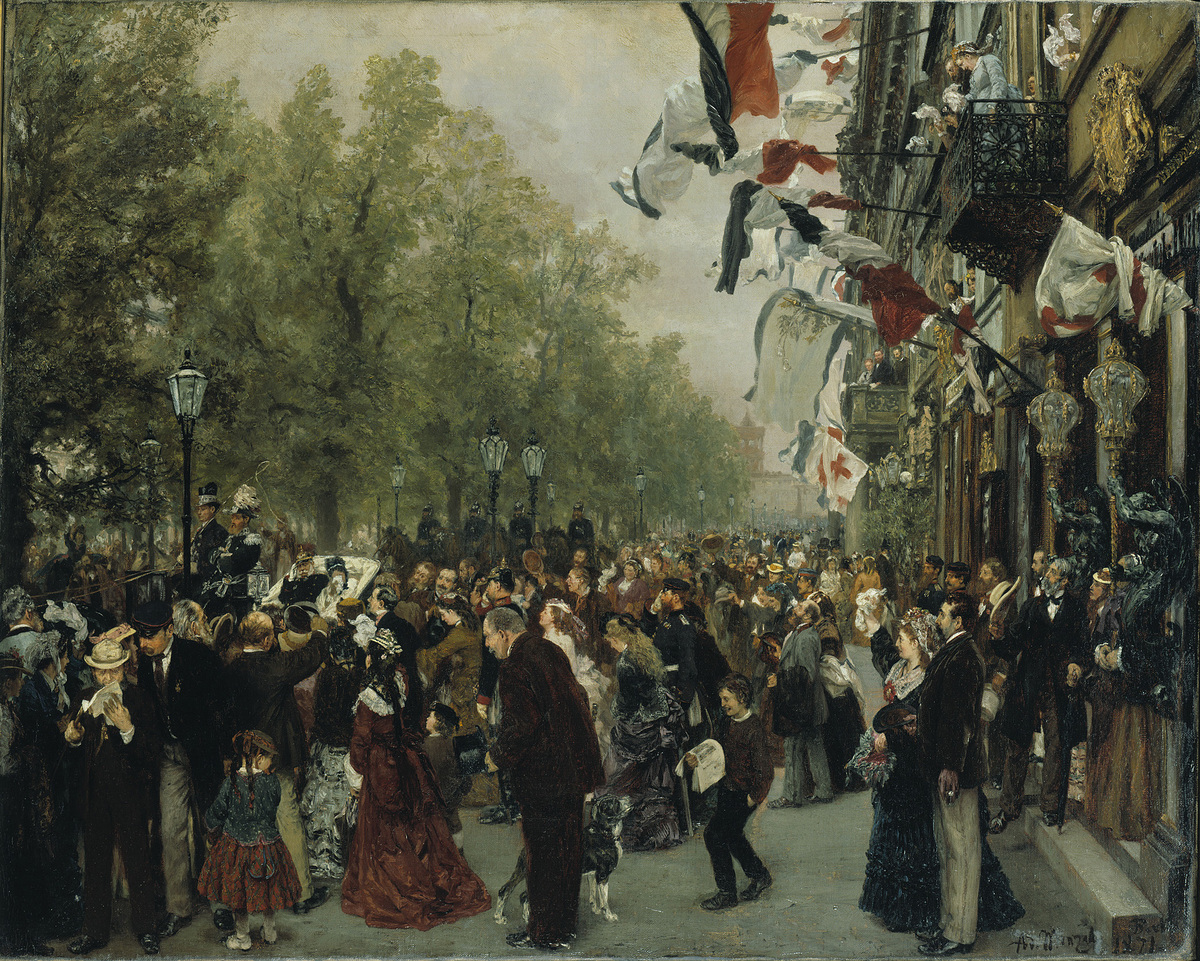Abstract
That Adolph Menzel (1815–1905) used the pretext of an historical
event to paint the crowds and facades of Berlin’s preeminent boulevard,
Unter den Linden, is suggested by the original title under which this
painting was exhibited: The Berlin Linden,
Afternoon of 31. July 1870. Having rushed back to Berlin from a
summer visit to the mountains of Saxony, Menzel encountered this scene
on the very day of his return. Along with countless others, he watched
as King Wilhelm I proceeded down Unter den Linden in his carriage, on
his way to the Potsdam train station to depart for the fighting front in
France (the Franco-Prussian War had broken out only two weeks
earlier).
The composition of the painting disappointed traditionalists of the
historical genre of realism. Why had Menzel chosen to hide the queen's
face behind a handkerchief and, for that matter, why was she crying when
the crowd was so jubilant? Why were the blue and white flags bearing the
Brandenburg eagle distinctly shapeless? Why did the bourgeois crowd so
overwhelm the royal couple? Why did Menzel choose to paint the prelude
to war, rather than one of the great battles or victory celebrations?
The answers, as so often with Menzel, have to remain speculative, but
more than a few compositional clues suggest his intention to depict
bourgeois Berlin rather than royal and martial Potsdam. The placement of
the king’s carriage to the far left side of Unter den Linden relegates
the royal couple to the literal margins of the scene. It is the crowd,
not the couple, that occupies center stage. Moreover, deep in the
background, at the termination of the avenue, one sees that Menzel has
allowed Berlin’s famous red-brick City Hall to tower over the indistinct
Royal Palace that stands in front of it. By altering the actual
relationship of the two buildings, and thereby giving city hall priority
over the palace, Menzel may have been gesturing towards civic—rather
than royal or martial—pride. (It should also be noted that other
prestigious buildings along this stretch of Unter den Linden are
conspicuously absent.) One other question arises: the German flags have
been wrapped around their poles by a gust of wind: is the new Germany
capable of flying yet? Less ambiguous is Menzel’s incorporation of the
Red Cross flag into his painting: as in most of his works—especially the
sketches drawn on the Bohemian battlefields of July 1866—the victims of
war were never far from his thoughts. To monarchist art critics like
Friedrich Pecht, writing in the Deutsches
Kunstblatt in 1881–82, even admiration for the painter’s virtuosity
could not disguise his disappointment that Menzel had offered
insufficient patriotic resolution and “too much sentimental
philistinism.” The novelist Theodore Fontane, in a letter to Menzel on
July 2, 1871, came closer to the truth when he praised the artist for
having “brought grandeur into everyday life.” (Theodor Fontane,
Briefe. Otto Drude and Helmuth
Nürnberger, eds., vol. 2, Munich, 1879, p. 382). The mistake of “so many
‘historians with the paintbrush,’” Fontane noted, was that they tried to
make authority palpable for ordinary Germans by infusing it with
concreteness. But Menzel’s own conception of history—and how to depict
it on the canvas—inverted the equation and privileged everyday life.
Thus, the aging king’s distinctly unheroic wave yields to the cumulative
effect of the numerous and varied individuals, gestures, and fabrics
that draw attention to themselves and take possession of the painting.
(Note that only one figure is actually genuflecting to royalty; two
others (at lower left) have turned their backs.) Thus, quite
intentionally, bourgeois Berlin takes center stage even as Germany’s
dynastic, international, and military history reaches a turning
point.
